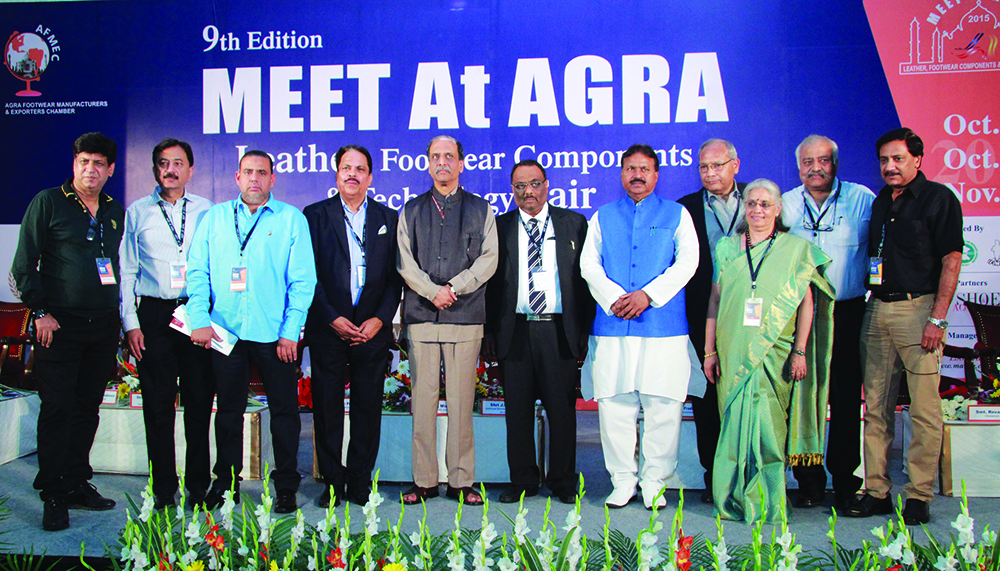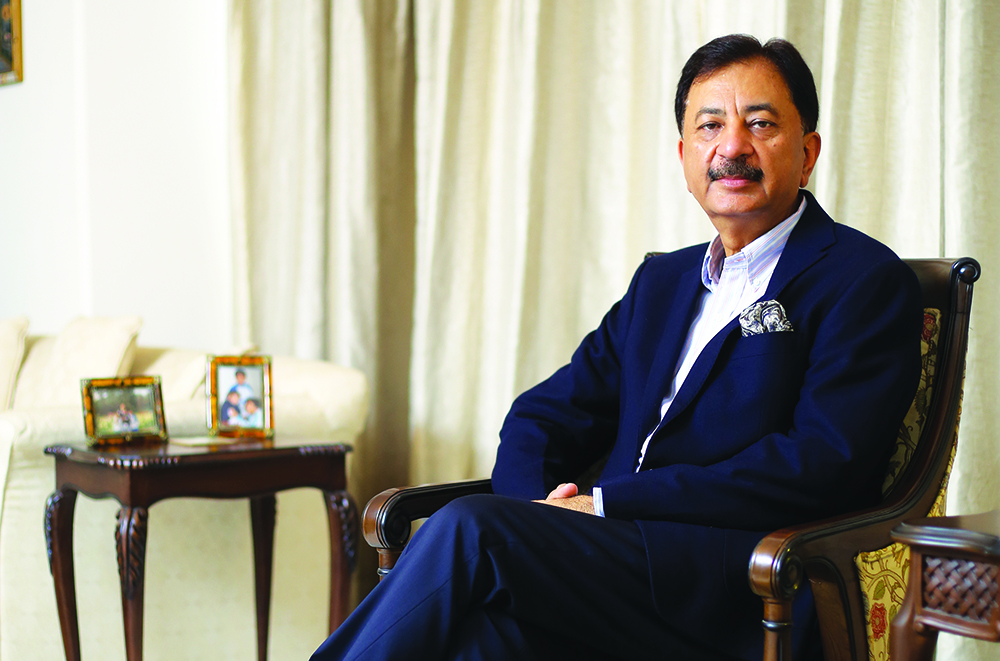RAJIV WASAN, General Secretary, Agra Footwear Manufacturers & Exporters Chambers (AFMEC), shares his views with S&A on Make in INDIA from the footwear industry perspectives. Rajiv is a seasoned and broad-experienced footwear exporter in Agra. With almost 4 decades of both commercial and operational experience, he was instrumental in AFMEC’s formation and its endeavors at many fronts. Rajiv possesses a rich academic career with a bachelor’s degree in Science from St. John’s College, University of Agra, a degree in Polymer Technology from National College of Rubber Technology , London and holds an honorary from LPRI, Plastics and Rubber Institute, London. He’s been actively involved in the family business since 1978.
What’s your opinion on Indian leather industry with respect to raw material and finished products?
Rajiv Wasan: The Indian industry has emerged as one of the most vibrant and fast-paced industries as several players, especially in retail, have started to enter the market. The country today is the 5th largest retail destination in the world. The leather industry is pegged at Rs 52K plus crore, the total footwear retail market has been growing at a CAGR of 12 per cent.
What are AFMEC’S primary objectives?
RW: Today, without doubt AFMEC is a strong and formidable voice of the industry. It shares the concerns of the industry with the governments both at state and national levels on regular basis. Since the past 10 years, AFMEC has been providing a very successful and vital platform for the industry at large under the aegis of Meet at Agra fair. This fair brings together technology and component partners from world over. It helps to upgrade technology, materials and exposure for the industry overall.
Currently, AFMEC is pursuing the development of Mega Leather Cluster, a world-class exhibition center, a globally acknowledged testing laboratory and a world-class design studio. Worldwide experts and government specialists are often invited to speak on seminars for the industry.
“Afmec has created a mega opportunity by establishing an outstanding platform for manufacturers – “MEET AT AGRA.”
Your views on regional or global co-operations.
RW: From a macro perspective, India should see an explosion in the manufacturing sector. However, we need to negotiate better deals at the WTO. For instance, Vietnam at the moment has free access to the European market while Indian exports have an import duty component, which makes our merchandise 4.65% more expensive. Hence, we are not as competitive as some of our competitors with other things equal.
What are the biggest risks for Indian leather industry as of now?
RW: Over the last 20 years, Indian manufacturing has by and large grown at the same pace as our overall economy. Our share of global manufacturing has grown from 0.9 to 2.0 percent during this period. Despite this encouraging growth, however, the relative share of manufacturing in the Indian economy has remained unchanged, dashing hopes of an economy based on manufacturing-led growth. Some of the Asian economies have increased their share of manufacturing tremendously. In India, the number of jobs in the sector has also remained low over the last twenty years; this contrasts with the services sector, which has increased phenomenally during the same period.
The risks, as I see it, are categorized into internal factors and external factors. Internally, the biggest risk for the Indian leather industry is not having a sustainable supply of raw material. We, at the moment, do not have systematic breeding programs. Secondly, we need to make the leather industry more attractive to the youth to have a sustainable labor force.
At the external end, we are heavily dependent on Europe and UK for our export market in Agra. This dependence causes undulations in the numbers year on year based on the economy and weather in Europe and UK. US is the biggest consumer of footwear in the world and we need to aggressively look at it as our new market. The time to depend on Europe and UK is over.
What has been the buying pattern internationally?
RW: Traditionally, footwear retailers usually stock their inventory months prior to the new season actually begins, with consumers also purchasing well in advance of the season. However, today’s consumers tend to buy closer to need. More importantly, the styles for a season are not likely to remain the same as those for the previous year, and are often determined during the season itself with the possibility of even changing in mid-season. This poses a challenge for companies as it implies that, in order to meet such demand they must significantly cut down on the time required for design, development, production, and distribution. Retailers and brands also need to develop an expertise in market research to truly understand buyers’ needs and current trends. Manufacturers should be in a position to do any mid-season corrections with low lead-times.
“A strong impetus on Make in India policy and adherence to quality manufacturing would make India the next factory for the world.”
Your views on Agra manufacturing viz a viz Make in India.
RW: One of Agra’s biggest draws is arguably its excellent quality of footwear that competes in the International market with global manufacturers of footwear. The strong manufacturing belt, the capability and capacity of Agra have turned the country into a coveted resource for the international footwear market and given rise to excellent market opportunity for India. Agra is the biggest footwear manufacturing centre of India and has the capacity of manufacturing more than 250 hundred thousand pairs of various types of footwear per day. It caters almost 50% of domestic footwear requirement and its share in overall export of leather footwear from the country is approximately 28% with a annual growth rate of 20 to 25 %. I suppose the above facts reinforce our belief and support for Make in India.
What about the manufacturing capacities and cost?
RW: Total manufacturing cost is central to deciding any manufacturing location, to assess India’s performance on the dimension of cost competitiveness. Look among the top 25 footwear exporting countries, India has one of the lowest manufacturing costs. Even though manufacturing wages have more than doubled over the last decade, these increases were offset by productivity gains and currency depreciation. The more important comparison is how we have fared over time. It is interesting to note that India has held steady over the years in terms of relative cost. This means that our cost increases have been dwarfed by that of many of our peers.
What are the biggest strengths of Indian manufacturers and exporters in the global market?
If brands want to deliver exciting shopping experiences, they need to have more control on where and how their products are manufactured, marketed, and distributed. Brands and retailers, who want to be successful, would have to have a complete control of the value chain i.e. from design to consumption. Few brands, despite having higher prices, achieve customer profitability, the sole reason being a strategy that results in excellent products and customer experiences. Today, I believe India stands tall in terms of high quality production and systems. A strong impetus on Make in India policy and adherence to quality manufacturing would make India the next factory for the world.
 What initiatives are being taken by AFMEC in this regard?
What initiatives are being taken by AFMEC in this regard?
Afmec has created a mega opportunity by establishing an outstanding platform for manufacturers – MEET AT AGRA. The exhibition, organized by AFMEC, has been opening with higher number of participants every year. The exhibition has been delivering the real need of providing a platform for interaction within India’s booming footwear industry. The objective of the exhibition is to provide a meeting place where those attending can witness a feeling for trends and innovations, compare pricing, do informal benchmarking, and meet both colleagues and customers to exchange news, views and the latest trade trends. Year on year, its has received a powerful response from the industry, with thousands of visitors from world over. Every year the enthusiasm displayed by the exhibitors and visitors hints at good business transaction. It provides a platform for potential customers and suppliers to meet face-to-face across the entire South Asia region. It encourages suppliers from the footwear and leather industry, manufacturers of footwear, leather garments, importers, exporters, designers, brand owners, distributors of leather components and product developers to meet under one roof.
MEET AT AGRA establishes its unique position in the footwear industry and is known as the premier event for national as well as international companies seeking opportunities in India’s huge market.
On future outlook.
RW: While optimism is certainly high, there is a long way to go before India can start to celebrate. The historic performance of the manufacturing sector has been below par, with especially poor results over the past few years, the mood in India across the broader industrial sector has started to shift lately. In the past year, the US, for instance, has experienced some of its strongest quarters. And although questions remain over whether Europe as a whole can return to growth, several economies within Europe have started strengthening. I believe Make in India is a sure shot boost for manufacturing growth. The government has made strategic visits overseas to drive increased investment, the results would certainly follow.
AFMEC
Agra footwear manufacturers exporters chambers (AFMEC) is a platform for Agra footwear industry to assist the members to upgrade our footwear community at large and has been working upon environmental awareness, new technologies upgradation, information sharing and national and international fair support.










